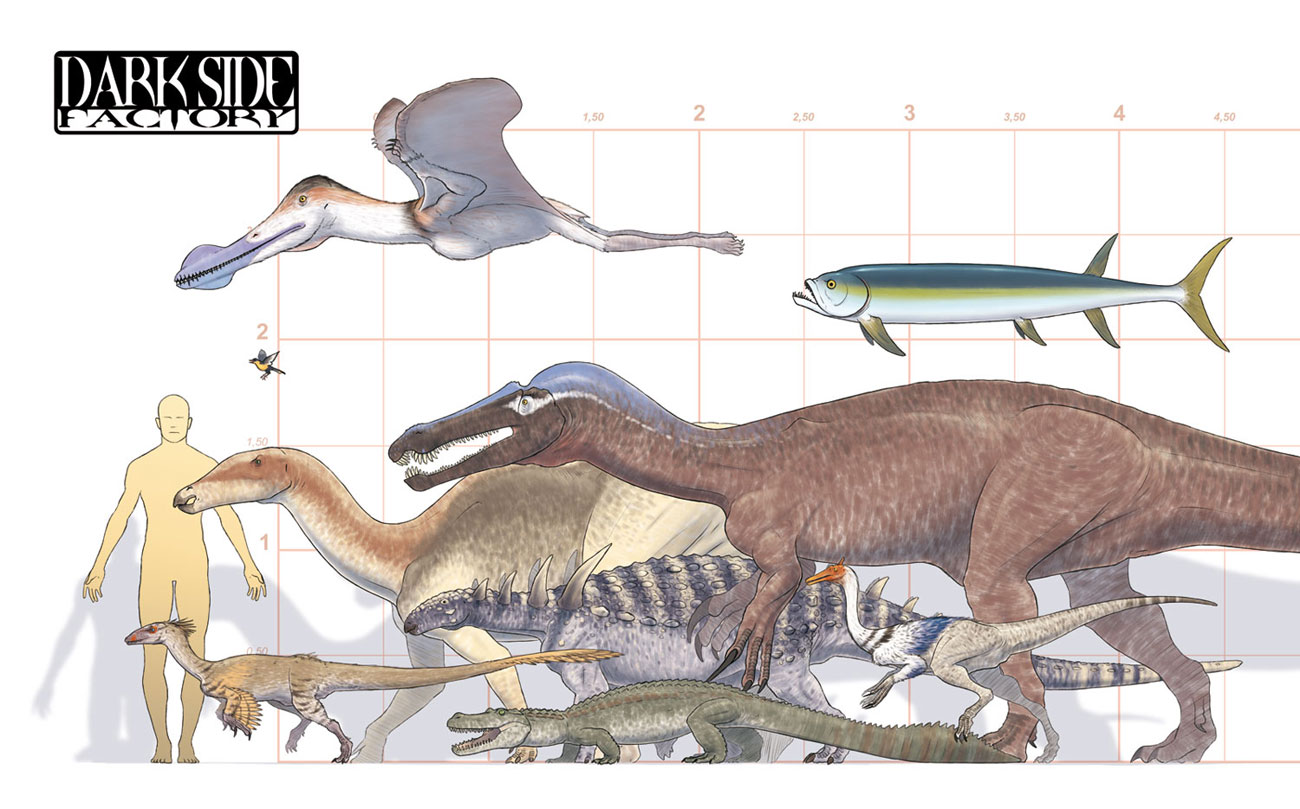| |
Titolo
- "Il Piccolo", il cast
Tratto - Matita B + Digitale nero 4 pixel
Colore - Digitale
Software - Adobe Photoshop CS
Hardware - Macintosh G5
Originale - Matita su carta - 42x29,7
Data - ottobre 2008
>Lascia
un commento su DeviantART<
Questa tavola
compare nel quarto libro della serie
"Dinosauri". Si tratta del cast completo del quarto volume,
in scala reciproca e con la sagoma di un essere umano medio dell'altezza
di 175cm.
Dopo esserci "rilassati" con un facile casting per il terzo
libro (sulla Morrison Formation), questo ci ha nuovamente impegnati.
Ambientato nell'Italia della metà del Cretaceo, unici elementi
certi erano il protagonista, Scipionyx, ed il coccodrillo (che
ancora non ha un nome). Per tutti gli altri abbiamo dovuto basarci su
qualche impronta (di ornitopode e di nodosauride) o prendendoli "in
prestito" da vicini ambienti simili della stessa epoca.
Ecco il cast.
• A sinistra in basso Scipionyx samniticus, teropode
di incerta classificazione e, fino ad ora, unico dinosauro "italiano"
ad essere stato ufficialmente descritto. Il fossile ritrovato appartiene
ad un cucciolo, mentre nella tavola vedete l'esemplare adulto, lungo
oltre 2 metri. Lo abbiamo ricostruito come se si trattasse di un Compsognatide.
• A destra in basso c'è un coccodrillo. Dalla caratteristica
testa corta ed appiattita, e con zampe posteriori molto lunghe, anche
di questo è stato ritrovato un fossile di un individuo giovane,
non ancora descritto.
• Ancora a destra Pelecanimimus polyodon, un ornitomimide
ritrovato in Spagna lungo quasi 2 metri.
• Dietro Pelecanimimus ecco il più grosso della
nostra storia, Baryonyx walkerii. Una specie di orso del mesozoico,
era lungo oltre 8 metri (forse fino a 11) ed era diffuso in Inghilterra
e in Nord Africa (Suchomimus). L'Italia si trova più
o meno nel mezzo, quindi abbiamo pensato che potesse essere presente
anche da noi.
• A sinistra dietro Baryonyx vediamo un Polacanthinae
generico, più o meno basato su Polacanthus e lungo circa
4 metri.
• Dietro al Nodosauro un altro "tizio" non definito,
un Ornitopode Iguanodonte. Lo abbiamo ricreato più o meno a metà
strada tra gli Iguanodonti e gli Adrosauri, conferendogli le sembianze
di un Ouranosaurus senza "vela". È lungo circa
5 metri.
• Sopra la testa dell'Ornitopode vedete il piccolo Iberomesornis
romerali, un uccello con denti ritrovato in Spagna.
• A sinistra della tavola, in volo, un grosso pterosauro Ornithocheiridae
con apertura alare di quasi 5 metri. Questo tipo di Pterosauri era largamente
diffuso all'epoca.
• Sospeso sopra Baryonyx, un Ichtyodectidae, parente
più piccolo dello spaventoso Xyphactinus americano. |
|
Title
- "Growing Up in the Cretaceous" cast
Ink - HB pencil + Digital black 4 pixels
Color - Digital
Software - Adobe Photoshop CS
Hardware - Macintosh G5
Original - Pencil on Paper - 42x29,7
Date - october 2008
>Leave
a comment on DeviantART<
This plate
is from the fourth volume of the
"Dinosaurs" series. You can see the whole cast from the
4th book in scale with the outline of an average 175cm tall human being.
After the easy job for the 3rd book casting (about the Morrison Formation),
things again became difficult for this book. Set in the middle Cretaceous
Italy, the only two sure "actors" were Scipionyx
and the crocodile (who is still unnamed). For the other "actors"
we had to look to some ornithopod and nodosaurid footprints, or "borrow"
them from similar environments around Europe and North Africa.
• Bottom left our protagonist Scipionyx samniticus, theropod
with an uncertain classification and – till now – the only
offically descibed "italian dinosaur". The fossil found is
a puppy, but in this plate you can see a fully grown adult more than
2m/6,5ft long. We restored it as a "big" Compsognathidae.
• Below on the right you can see a still unnamed crocodile based
on a juvenile fossil skeleton. It has a typical short and flat head
and very long hindlimbs.
• Still more to the right Pelecanimimus polyodon, a 2m/6,5ft
long Ornithomimidae found in Spain's early cretaceous.
• Behind Pelecanimumus the biggest dinosaur of this book:
Baryonyx walkerii. It was a sort of mesozoic bear more than
8m/26ft long (maybe up to 11m/36ft long), it lived from England to North
Africa (Suchomimus). Italy lies roughly between these areas,
so we though that Baryonyx lived here too.
• On the left behind of Bayonyx you can see a generic
Polacanthinae, roughly based on Polacanthus and more or less
4m/13ft long.
• Behind the Nodosaurid another "John Doe" dinosaur,
an Iguanodontid Ornithopod. We restored it as an animal between Iguanodontids
and Hadrosaurids, giving it the look of a sail-less Ouranosaurus.
It's 5m/16ft long.
• Over the head of the Ornithopod you can see the small Iberomesornis
romerali, a toothed bird found in Spain's early cretaceous.
• Leftmost there's a flying Ornithocheiridae pterosaur, whose
wingspan is more than 5m/16ft wide.
• Above Baryonyx there's an Ichtyodectidae fish, a small Xyphactinus
relative. |
|









